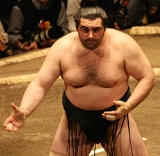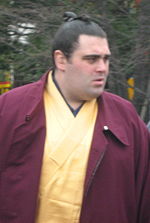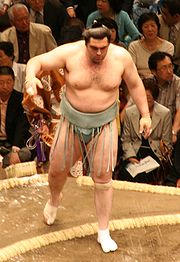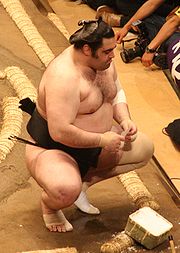
Kokkai Futoshi
Encyclopedia
Kokkai Futoshi is a professional sumo
wrestler from Georgia
. He began his career in May 2001. He is the first Caucasian rikishi to reach sumo's highest division, makuuchi
, which he achieved in 2004. His highest rank has been komusubi, which he reached in 2006. He has earned two special prizes
for Fighting Spirit and two gold stars
for defeating yokozuna. He wrestles for Oitekaze stable
.
 Kokkai was born as Levan Tsaguria in Sukhumi
Kokkai was born as Levan Tsaguria in Sukhumi
, Abkhaz Autonomous Republic in then-Soviet Georgia. The secessionist war in Abkhazia forced his family to move to Tbilisi
, capital of Georgia, in 1992. He started amateur wrestling from the age of six, being taught by his father who represented the Soviet Union
in the sport. Levan enrolled in the National Academy of Sports of Georgia and quickly got interested in sumo, taking part in the World Amateur Sumo Championships in Riesa
, Germany
. In January 2001, he arrived in Tokyo
, Japan
, and joined a local sumo school.
He made his professional debut in May 2001, joining Oitekaze stable
. His stablemaster, former maegashira Daishoyama, gave him the shikona
or ring name of Kokkai, named after the word for Black Sea
in Japanese
. He quickly rose through the lower divisions, winning the jonidan and sandanme championships with perfect 7-0 records. Another tournament title in the makushita division in January 2003 followed by a 5-2 score at Makushita 1 saw him reach elite sekitori
status in May 2003. After winning the jūryō division championship with a 14-1 record in November 2003 he was promoted to the top makuuchi
division in January 2004, just 16 tournaments after his debut.
 Kokkai steadily climbed the maegashira ranks, reaching the #1 position in November 2004 before slipping back slightly. One of his best performances came in July 2005 when he defeated yokozuna Asashōryū
Kokkai steadily climbed the maegashira ranks, reaching the #1 position in November 2004 before slipping back slightly. One of his best performances came in July 2005 when he defeated yokozuna Asashōryū
for the first time, scored nine wins and was awarded the Fighting Spirit prize. He made his sanyaku debut in September 2006 at komusubi rank and held it with a solid 8-7 record, but he fell back to the maegashira ranks after a back injury restricted him to a poor 3-12 mark in November.
In March 2007 he turned in an impressive 10-5 score but he struggled again in May 2007, only managing three wins at the rank of maegashira 2. After another losing score in July of that year he fell to maegashira 12 in September, his lowest ever top division rank. He managed nine wins in November 2007, his first kachi-koshi or winning score since March.
After a solid 9-6 performance in January 2008, in the following tournament he produced his best ever top division result, a 12-3 score from the rank of maegashira 5, which earned him joint runner-up honours and his second Fighting Spirit prize. However, in the May 2008 tournament he could only manage three wins from the maegashira 1 ranking. Demoted to maegashira 10 for July, he struggled again, winning only five bouts. He was disqualified from his final match against Kimurayama after his was judged to have pulled his opponent's topknot
, which is a kinjite
or foul. Kokkai maintained it was accidental as the tape on his fingers had stuck to Kimurayama's hair. He continued to move up and down the maegashira rankings in 2009, alternating between 8-7 and 5-10 records.
He has not missed a bout since his debut and in July 2010 fought his 600th consecutive top division match. Troubled by an elbow injury, he lost his top division status after the January 2011 tournament when he could only score 3-12 at Maegashira 15, ending a run of 43 consecutive tournaments ranked in makuuchi. Back in juryo for the May Technical Examination Tournament, he struggled to a 5-10 score. He returned to the top division in September 2011, but his stay was short-lived after a disastrous 1-14 performance in November.
 Kokkai has been joined in the top division by several wrestlers from Eastern Europe, including Kotoōshū
Kokkai has been joined in the top division by several wrestlers from Eastern Europe, including Kotoōshū
from Bulgaria
, Aran
from Russia
, and Baruto
from Estonia
. In May 2008 a fellow Georgian, Tochinoshin, was also promoted to makuuchi, and Kokkai defeated him in their first match that July. Kokkai is also good friends with former top division wrestler Kakizoe.
He has knowledge of four languages: Georgian
, Russian
, English
and Japanese
.
He is a devout Christian
and prays every day.
He will sometimes choose not to shave during a tournament for superstitious reasons and will therefore build up stubble
, unusual for sumo wrestlers who are normally clean-shaven. In a recent tournament he also appeared with prominent sideburns
for a few days, before he was told by his stablemaster to shave them off.
, gripping his opponent's belt, switching from the pushing and thrusting techniques
he used earlier in his career. His profile at the Japan Sumo Association
still lists tsuki/oshi as his favoured techniques, and his most common winning kimarite
is oshi-dashi or push out, followed by yori-kiri or force out. He is also fond of using the slap down (hataki-komi) and the pull down, hiki-otoshi.
Kokkai was married to a 22 year old from his native Georgia in August 2011.
Sumo
is a competitive full-contact sport where a wrestler attempts to force another wrestler out of a circular ring or to touch the ground with anything other than the soles of the feet. The sport originated in Japan, the only country where it is practiced professionally...
wrestler from Georgia
Georgia (country)
Georgia is a sovereign state in the Caucasus region of Eurasia. Located at the crossroads of Western Asia and Eastern Europe, it is bounded to the west by the Black Sea, to the north by Russia, to the southwest by Turkey, to the south by Armenia, and to the southeast by Azerbaijan. The capital of...
. He began his career in May 2001. He is the first Caucasian rikishi to reach sumo's highest division, makuuchi
Makuuchi
or is the top division of professional sumo. Its size is fixed at 42 wrestlers , ordered into five ranks according to their ability as defined by their performance in previous tournaments....
, which he achieved in 2004. His highest rank has been komusubi, which he reached in 2006. He has earned two special prizes
Sansho (Sumo)
Sanshō are the three special prizes awarded to top division sumo wrestlers for exceptional performance during a sumo honbasho or tournament. The prizes were first awarded in November 1947.-Criteria:...
for Fighting Spirit and two gold stars
Kinboshi
Kinboshi is a notation used in professional sumo wrestling to record a lower-ranked wrestler's victory over a yokozuna....
for defeating yokozuna. He wrestles for Oitekaze stable
Oitekaze stable
The is a stable of sumo wrestlers, part of the Tatsunami ichimon or group of stables. It was established in its modern incarnation on 1 October 1998 by former maegashira Daishoyama, who is the stable's current head coach...
.
Early career

Sukhumi
Sukhumi is the capital of Abkhazia, a disputed region on the Black Sea coast. The city suffered heavily during the Georgian-Abkhaz conflict in the early 1990s.-Naming:...
, Abkhaz Autonomous Republic in then-Soviet Georgia. The secessionist war in Abkhazia forced his family to move to Tbilisi
Tbilisi
Tbilisi is the capital and the largest city of Georgia, lying on the banks of the Mt'k'vari River. The name is derived from an early Georgian form T'pilisi and it was officially known as Tiflis until 1936...
, capital of Georgia, in 1992. He started amateur wrestling from the age of six, being taught by his father who represented the Soviet Union
Soviet Union
The Soviet Union , officially the Union of Soviet Socialist Republics , was a constitutionally socialist state that existed in Eurasia between 1922 and 1991....
in the sport. Levan enrolled in the National Academy of Sports of Georgia and quickly got interested in sumo, taking part in the World Amateur Sumo Championships in Riesa
Riesa
Riesa is a town in the district of Meißen in the Free State of Saxony, Germany. It is located at the river Elbe, approx. 40 km northwest of Dresden.The world's first 110 kV power line was inaugurated between Riesa and Lauchhammer in 1912....
, Germany
Germany
Germany , officially the Federal Republic of Germany , is a federal parliamentary republic in Europe. The country consists of 16 states while the capital and largest city is Berlin. Germany covers an area of 357,021 km2 and has a largely temperate seasonal climate...
. In January 2001, he arrived in Tokyo
Tokyo
, ; officially , is one of the 47 prefectures of Japan. Tokyo is the capital of Japan, the center of the Greater Tokyo Area, and the largest metropolitan area of Japan. It is the seat of the Japanese government and the Imperial Palace, and the home of the Japanese Imperial Family...
, Japan
Japan
Japan is an island nation in East Asia. Located in the Pacific Ocean, it lies to the east of the Sea of Japan, China, North Korea, South Korea and Russia, stretching from the Sea of Okhotsk in the north to the East China Sea and Taiwan in the south...
, and joined a local sumo school.
He made his professional debut in May 2001, joining Oitekaze stable
Oitekaze stable
The is a stable of sumo wrestlers, part of the Tatsunami ichimon or group of stables. It was established in its modern incarnation on 1 October 1998 by former maegashira Daishoyama, who is the stable's current head coach...
. His stablemaster, former maegashira Daishoyama, gave him the shikona
Shikona
A shikona is a sumo wrestler's ring name.As with standard Japanese names, a shikona consists of a 'surname' and a 'given' name, and the full name is written surname first. However, the given name is rarely used outside formal or ceremonial occasions. Thus, the former yokozuna Asashōryū Akinori is...
or ring name of Kokkai, named after the word for Black Sea
Black Sea
The Black Sea is bounded by Europe, Anatolia and the Caucasus and is ultimately connected to the Atlantic Ocean via the Mediterranean and the Aegean seas and various straits. The Bosphorus strait connects it to the Sea of Marmara, and the strait of the Dardanelles connects that sea to the Aegean...
in Japanese
Japanese language
is a language spoken by over 130 million people in Japan and in Japanese emigrant communities. It is a member of the Japonic language family, which has a number of proposed relationships with other languages, none of which has gained wide acceptance among historical linguists .Japanese is an...
. He quickly rose through the lower divisions, winning the jonidan and sandanme championships with perfect 7-0 records. Another tournament title in the makushita division in January 2003 followed by a 5-2 score at Makushita 1 saw him reach elite sekitori
Sekitori
A sekitori is a sumo wrestler who is ranked in one of the top two professional divisions: makuuchi and juryo.Currently there are 70 rikishi in these divisions...
status in May 2003. After winning the jūryō division championship with a 14-1 record in November 2003 he was promoted to the top makuuchi
Makuuchi
or is the top division of professional sumo. Its size is fixed at 42 wrestlers , ordered into five ranks according to their ability as defined by their performance in previous tournaments....
division in January 2004, just 16 tournaments after his debut.
Top division career

Asashōryū Akinori
is a former sumo wrestler from Ulaanbaatar, Mongolia. He was the 68th yokozuna in the history of the sport in Japan and became the first Mongol to reach sumo's highest rank in January 2003. He was one of the most successful yokozuna ever. In 2005 he became the first man to win all six official...
for the first time, scored nine wins and was awarded the Fighting Spirit prize. He made his sanyaku debut in September 2006 at komusubi rank and held it with a solid 8-7 record, but he fell back to the maegashira ranks after a back injury restricted him to a poor 3-12 mark in November.
In March 2007 he turned in an impressive 10-5 score but he struggled again in May 2007, only managing three wins at the rank of maegashira 2. After another losing score in July of that year he fell to maegashira 12 in September, his lowest ever top division rank. He managed nine wins in November 2007, his first kachi-koshi or winning score since March.
After a solid 9-6 performance in January 2008, in the following tournament he produced his best ever top division result, a 12-3 score from the rank of maegashira 5, which earned him joint runner-up honours and his second Fighting Spirit prize. However, in the May 2008 tournament he could only manage three wins from the maegashira 1 ranking. Demoted to maegashira 10 for July, he struggled again, winning only five bouts. He was disqualified from his final match against Kimurayama after his was judged to have pulled his opponent's topknot
Chonmage
The chonmage is a form of Japanese traditional haircut worn by men. It is most commonly associated with the Edo Period and samurai, and in recent times with sumo wrestlers...
, which is a kinjite
Kinjite
Kinjite are various fouls that a sumo wrestler might commit that will cause him to lose the bout. They are:* Striking the opponent with a closed fist.* Grabbing the opponent’s hair....
or foul. Kokkai maintained it was accidental as the tape on his fingers had stuck to Kimurayama's hair. He continued to move up and down the maegashira rankings in 2009, alternating between 8-7 and 5-10 records.
He has not missed a bout since his debut and in July 2010 fought his 600th consecutive top division match. Troubled by an elbow injury, he lost his top division status after the January 2011 tournament when he could only score 3-12 at Maegashira 15, ending a run of 43 consecutive tournaments ranked in makuuchi. Back in juryo for the May Technical Examination Tournament, he struggled to a 5-10 score. He returned to the top division in September 2011, but his stay was short-lived after a disastrous 1-14 performance in November.

Kotooshu Katsunori
Kotoōshū Katsunori is a professional sumo wrestler or rikishi. He made his debut in 2002, reaching the top division just two years later...
from Bulgaria
Bulgaria
Bulgaria , officially the Republic of Bulgaria , is a parliamentary democracy within a unitary constitutional republic in Southeast Europe. The country borders Romania to the north, Serbia and Macedonia to the west, Greece and Turkey to the south, as well as the Black Sea to the east...
, Aran
Aran Hakutora
Aran Hakutora is a Russian sumo wrestler. He began his professional career in January 2007 and made the top division in a record eleven tournaments. The highest rank he has reached is sekiwake...
from Russia
Russia
Russia or , officially known as both Russia and the Russian Federation , is a country in northern Eurasia. It is a federal semi-presidential republic, comprising 83 federal subjects...
, and Baruto
Baruto Kaito
Baruto Kaito is a professional sumo wrestler from Estonia. Making his debut in May 2004, he is one of only two Estonians ever to join the sport in Japan, and the first to reach the top division, in May 2006...
from Estonia
Estonia
Estonia , officially the Republic of Estonia , is a state in the Baltic region of Northern Europe. It is bordered to the north by the Gulf of Finland, to the west by the Baltic Sea, to the south by Latvia , and to the east by Lake Peipsi and the Russian Federation . Across the Baltic Sea lies...
. In May 2008 a fellow Georgian, Tochinoshin, was also promoted to makuuchi, and Kokkai defeated him in their first match that July. Kokkai is also good friends with former top division wrestler Kakizoe.
He has knowledge of four languages: Georgian
Georgian language
Georgian is the native language of the Georgians and the official language of Georgia, a country in the Caucasus.Georgian is the primary language of about 4 million people in Georgia itself, and of another 500,000 abroad...
, Russian
Russian language
Russian is a Slavic language used primarily in Russia, Belarus, Uzbekistan, Kazakhstan, Tajikistan and Kyrgyzstan. It is an unofficial but widely spoken language in Ukraine, Moldova, Latvia, Turkmenistan and Estonia and, to a lesser extent, the other countries that were once constituent republics...
, English
English language
English is a West Germanic language that arose in the Anglo-Saxon kingdoms of England and spread into what was to become south-east Scotland under the influence of the Anglian medieval kingdom of Northumbria...
and Japanese
Japanese language
is a language spoken by over 130 million people in Japan and in Japanese emigrant communities. It is a member of the Japonic language family, which has a number of proposed relationships with other languages, none of which has gained wide acceptance among historical linguists .Japanese is an...
.
He is a devout Christian
Christian
A Christian is a person who adheres to Christianity, an Abrahamic, monotheistic religion based on the life and teachings of Jesus of Nazareth as recorded in the Canonical gospels and the letters of the New Testament...
and prays every day.
He will sometimes choose not to shave during a tournament for superstitious reasons and will therefore build up stubble
Stubble
Stubble is the regrowth of shaven hair, when it is short and has a rough, abrasive texture.-Facial:During the 1980s, facial stubble on men became fashionable, partly due to being popularized by the singer George Michael, as well as Miami Vice. This was also known as designer stubble and was...
, unusual for sumo wrestlers who are normally clean-shaven. In a recent tournament he also appeared with prominent sideburns
Sideburns
Sideburns or sideboards are patches of facial hair grown on the sides of the face, extending from the hairline to below the ears and worn with an unbearded chin...
for a few days, before he was told by his stablemaster to shave them off.
Fighting style
Due to a neck injury, Kokkai has been forced to change his sumo style. He has begun to fight more on the mawashiMawashi
In sumo, a mawashi is the belt that the rikishi wears during training or in competition. Upper ranked professional wrestlers wear a keshō-mawashi as part of the ring entry ceremony or dohyo-iri.-Mawashi:...
, gripping his opponent's belt, switching from the pushing and thrusting techniques
Kimarite
Kimarite are winning techniques in a sumo bout. For each bout in a Grand Sumo tournament , a sumo referee, or gyoji, will decide and announce the type of kimarite used by the winner...
he used earlier in his career. His profile at the Japan Sumo Association
Japan Sumo Association
The is the body that operates and controls professional sumo wrestling in Japan under the jurisdiction of the Japanese Ministry of Education, Culture, Sports, Science and Technology. Rikishi , gyōji , tokoyama , and yobidashi , are all on the Association's payroll, but the organisation is run...
still lists tsuki/oshi as his favoured techniques, and his most common winning kimarite
Kimarite
Kimarite are winning techniques in a sumo bout. For each bout in a Grand Sumo tournament , a sumo referee, or gyoji, will decide and announce the type of kimarite used by the winner...
is oshi-dashi or push out, followed by yori-kiri or force out. He is also fond of using the slap down (hataki-komi) and the pull down, hiki-otoshi.
Family
Kokkai's younger brother George also became a professional sumo wrestler in September 2005 under the name Tsukasaumi, but quit after just a year because of persistent injuries, returning to Georgia to take over the family business.Kokkai was married to a 22 year old from his native Georgia in August 2011.
Tournament record
See also
- Glossary of sumo termsGlossary of sumo termsThe following words are terms used in sumo wrestling in Japan. azukari : Hold. A kind of draw. After a mono-ii, the gyōji or the shimpan "holds" the result if it was too close to call...
- List of sumo tournament second division winners
- List of active sumo wrestlers
External links
- Japanese Sumo Association Biography (English)

